Glasgow’s Burrell Collection was recently awarded the coveted Art Fund Museum Of The Year 2023. The extensive collection was gifted to the city of Glasgow by the shipping magnate Sir William Burrell.
In the year since it has re-opened to the public, over 500,000 visitors have headed to Pollok Park in Glasgow’s Southside to see the collection for themselves. In this blog, we’ll take a look at the Burrell Collection and discover the story of the man behind it.
Who was Sir William Burrell?
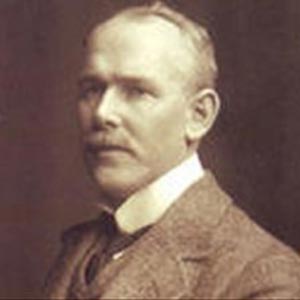
William Burrell was born in 1861. At an early age, he developed an interest in art, buying his first painting whilst still at school and getting the money from selling a cricket bat.
He joined the family shipping company age 15 years. When his father died, William and his brother George took control of the company. Under their control, the company flourished and expanded from small canal vessels into a fleet of ocean-going ships.
While George concentrated on engineering matters, William travelled the World setting up a network of agents to keep the ever-expanding fleet of ships fully employed.
Burrell Collection Art
His Global expeditions allowed him to pursue his interests in art collecting. He had built up considerable knowledge through self-education and was known for having an eye for detail and eclectic tastes.
Sir William Burrell’s philanthropic endeavours extended beyond his love of art. He also made significant contributions to various charities and causes throughout his lifetime. Burrell was knighted in 1927 for his services to the arts.
Sir William Burrell died in 1958 at his beloved Hutton Castle in the Scottish Borders.
What is the Burrell Collection?
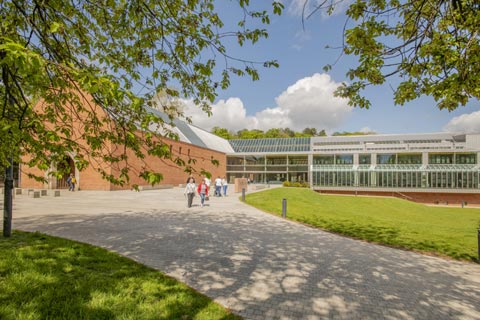
By the time Burrell’s shipping company closed in 1939, Sir William Burrell had amassed a collection of some 9,000 pieces spanning over 6,000 years of history. Five years later, he and his wife, Constance, donated his collection to the City of Glasgow together with a gift of £250,000 to build a suitable museum to house it.
In those days, Glasgow was an industrial city, and Burrell stipulated that the collection should be housed in a rural location far away from the city’s pollution. He feared his tapestries and carpets would quickly deteriorate otherwise.
In 1983 a purpose-built gallery was opened in Pollok Park on the southside of Glasgow. When the gallery first opened, it attracted high visitor numbers, but over the years, attendance fell dramatically. The collection was closed to the public in 2016 for a substantial makeover.
Official Opening
After five years, the £68.25 Million refurbishment was complete, and the collection was opened to the public once more. On 13 October 2022, King Charles III officially opened the Burrell Collection, almost 40 years after his mother, Queen Elizabeth II opened the original building in 1983.
Burrell Collection Exhibitions
Around 2,000 items in the collection are exhibited at any given time ranging from ancient Egyptian artefacts to medieval tapestries, from Chinese ceramics to French Impressionist paintings.
Highlights of the collection include works by renowned artists such as Rodin, Degas, and Cézanne, as well as rare manuscripts and armour from medieval Europe.
Must-see exhibits include
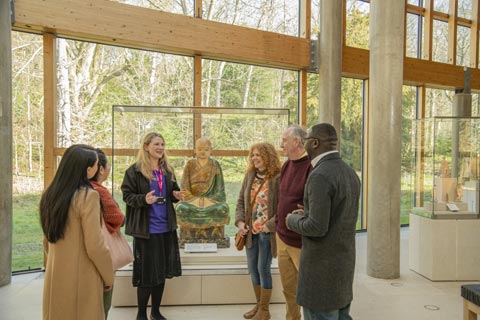
Girl on Bicycle - Joseph Crawhall
The Red Ballet Skirts - Edgar Degas
The Thinker, Auguste Rodin
One of the World’s most recognisable sculptures, The Thinker sits with a furrowed brow, coiled like a spring. His tense pose suggests the power and weight of human thought.
Figure of a Luohan from the Ming Dynasty
Two Tomb Guardians from the Tang Dynasty
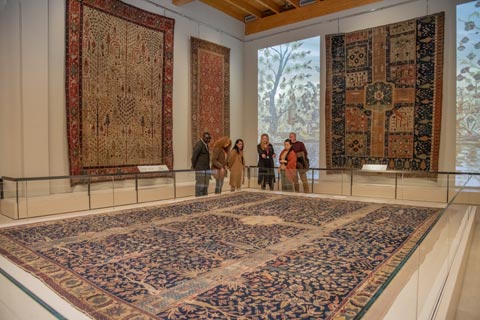
Warwick Vase
Found in the villa of the Emperor Hadrian outside Rome, the Warwick Vase was restored and gifted to the Earl of Warwick in 1774. Later, it found a home in The Burrell Collection.
Stained Glass Window, Life of Jesus Christ and the Virgin Mary - circa 1444
The Wagner Garden Carpet
The garden design on this carpet is crammed with shrubs and trees, animals and birds intersected by water channels and a pool full of fish and ducks.
Pink Roses - S.J Peploe
Self Portrait - Rembrandt van Rijn
How to get to the Burrell Collection
Despite having a semi-rural location, it’s easy to get to the Burrell Collection by public transport.
Train
The nearest station is Pollokshaws West. ScotRail Trains on the Barrhead and Kilmarnock routes serve Pollokshaws West. The journey time from Glasgow Central is a mere 9 minutes, and with up to 64 trains a day, you’ll not have to wait long.
Bus
First Glasgow Bus services 57 & 57A plus McGills service 3 stop on Pollokshaws Road, at the entrance to Pollok Park.
Shuttle Bus
The main entrance to the park is at 2060 Pollokshaws Road. A network of signed pathways makes walking to the Burrell Collection and the other attractions in the park is easy.
A free shuttle bus operates every 30 minutes between 10:00 hrs and 18:15 hrs daily from the entrance to the park (you’ll find the bus stop inside the park at 2060 Pollokshaws Road, walk under the railway bridge).
The electric bus serves The Burrell Collection and Pollok House and can accommodate one wheelchair.
Pollok Park
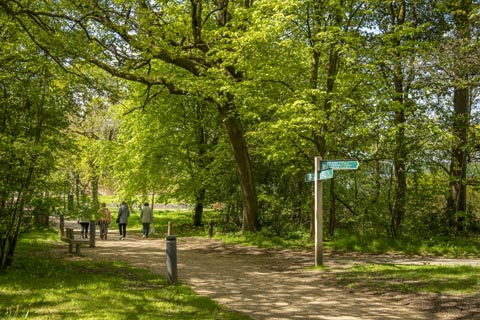
The Burrell Collection is one of several attractions in the award-winning Pollok Country Park. Nestled in the south of the city, Pollok Park is a sprawling green oasis of over 146 hectares, making it the city’s largest park.
The park is home to diverse wildlife, from squirrels and rabbits to majestic deer that roam freely through the woodlands.
Birdwatchers will be delighted by the assortment of avian species that call the park home, including woodpeckers, owls, and waterfowl that inhabit the picturesque Pollok Pond.
The park has a team of rangers who provide a outdoor learning opportunities for schools and guided nature walks for residents and visitors.
Pollok Park History
The park was once part of the Old Pollok Estate, owned by the Maxwell and Maxwell MacDonald families for over 800 years. This family played a significant role in Scottish history, including supporting Mary Queen of Scots at the nearby Battle of Langside in 4568.
In 1966, the park and Pollok House were gifted to the City of Glasgow by Anne Maxwell MacDonald.
Pollok Country Park has won the coveted Best Park in Britain and Best Park in Europe awards.
Pollok House
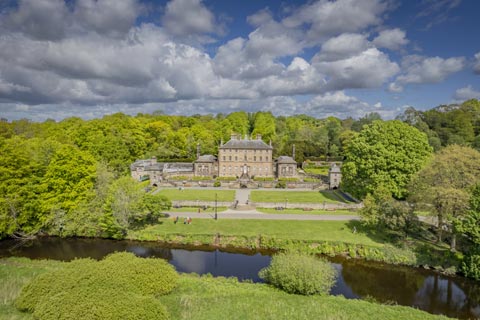
Pollok House is a grand Georgian mansion built in the mid-18th century and is considered one of Scotland’s finest Georgian mansions. It was designed by renowned architect William Adam for Sir George Maxwell, a member of the wealthy Maxwell family.
Now in the care of the National Trust for Scotland, Pollok House is famous for its intricate plasterwork and a magnificent sweeping staircase. The house boasts a remarkable collection of period furniture, lavish carpets, and impressive artwork, making every room a feast for the eyes.
Visitors flock to enjoy the exceptional art collection, featuring masterpieces from renowned artists such as El Greco, William Blake, and Sir Henry Raeburn. The impressive array of paintings, sculptures, and decorative arts offers a comprehensive overview of various artistic periods and styles.
Below Stairs
If you visit Pollok House, don’t miss the opportunity to visit the fascinating Servants’ Quarters. Discover how the real Mr Carsons and Mrs Patmore’s of this house went about serving the family upstairs.
From the kitchen, where meals were prepared, to the butler’s pantry and the various chambers, you’ll learn all about the lives of the staff who worked tirelessly behind the scenes.
You can also enjoy scrumptious cakes and scones in the Kitchen Café. It’s the ideal way to end a visit to Pollok House.
Pollok Park Highland Cows
No blog about Pollok Country Park would be complete without mentioning the Hairy Coo’s.
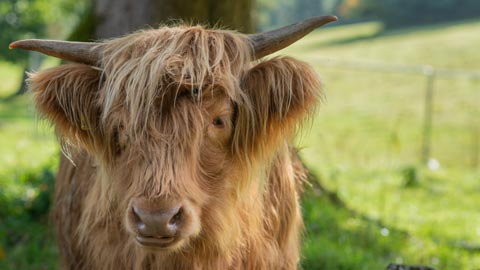
The park is home to a famous herd of around 50 Highland cattle, or “Highland Coos” as we call them in Scotland. Highland cattle are characterised by their long horns and shaggy coats. They are well-suited to the rugged terrain and harsh weather conditions of the Scottish Highlands.
The park provides an ideal home for these magnificent animals, allowing them to graze and roam freely. The cattle play an essential role in maintaining the park’s biodiversity by grazing on the grasslands and helping to control vegetation growth.
Many visitors enjoy photographing the “Hairy Coos” and watching them up close.
Discover Glasgow’s many treasures with Scottish Tours
It’s easy to visit Glasgow on your own or as part of an escorted tour or a short break from London.
As a Glasgow-based company, we take great pride in showing visitors the many highlights of Scotland’s largest city. We look forward to welcoming you soon.
Discover more from Scottish Tours today.
Photo credits: Glasgow Life

